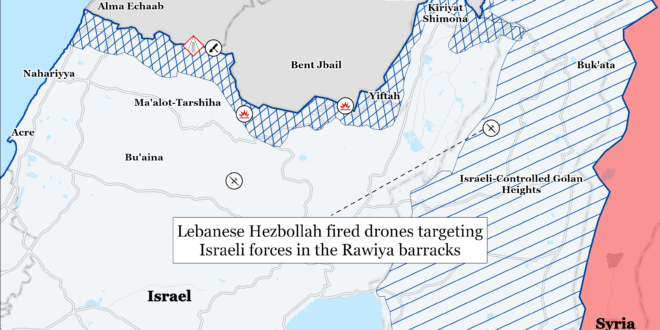The United States and foreign mediators seem to be attempting to delay or indefinitely postpone an Iranian and Hezbollah attack targeting Israel by both threatening Iran and presenting a potential ceasefire-hostage agreement as an off-ramp from further regional escalation. Both the United States and Israel have signaled that a strike would be met with a significant military response while indicating optimism towards a ceasefire-hostage agreement. The United States recently warned Iran that an Iranian attack on Israel could trigger a “robust military response” from Israel.[1] Israel practiced aerial refueling of fighter jets in Israeli airspace and “simulated long-range flights deep into enemy territory” on August 16 to signal to Iran and Hezbollah its readiness to respond to any attack.[2] CTP-ISW continues to assess that Iran likely seeks to restore deterrence with Israel while simultaneously trying to avoid a large-scale war with Israel.[3] A major military response against Iran in the wake of an Iranian strike would demonstrate it had not re-established deterrence while simultaneously increasing the risk of a wider war.
The United States and foreign mediators are also framing a potential ceasefire-hostage agreement as a necessary measure to deescalate tensions in the region. US President Joe Biden reportedly views the deal as the “key…to preventing a regional war,” and he said that he “expects” that Iranian leaders will delay or indefinitely postpone a strike if a ceasefire agreement is reached.[4] It remains unclear if “hold off” means that Iranian leaders would decline to mount any retaliatory strike on Israel, or just that Iran would delay its strike. Qatari Prime Minister Mohammed bin Abdulrahman bin Jassim al Thani warned Iran about the “grave consequences” of conducting an attack on Israel “at the very moment there are signs of diplomatic progress” during a phone call with Iranian Acting Foreign Affairs Minister Ali Bagheri Kani on August 15, according to an unspecified diplomat who spoke to the Washington Post.[5] It is unclear whether the “grave consequences” Thani warned Iran about are related to the current military situation in the Gaza Strip or in the region more broadly.
There are some indications that Iran will wait until the current ceasefire negotiations conclude to conduct an attack on Israel. The United States, Egypt, and Qatar announced on August 16 that ceasefire negotiations will resume in Cairo “before the end of next week.”[6] CBS reported that the United States previously assessed that Iran would not attack Israel during the two-day ceasefire negotiations in Doha on August 15 and 16.[7] It is unclear, however, whether Iran will postpone its attack until the next round of negotiations in Cairo takes place. Iranian Supreme Leader Ali Khamenei said on August 14 that a “non-tactical retreat” from a retaliatory strike targeting Israel was unacceptable, implying that a tactical retreat would be acceptable.[8] This suggests Khamenei may have delayed the strike to account for ceasefire negotiations. Five Israeli officials told the New York Times on August 16 that the Israeli intelligence community assessed that Iran and Hezbollah have lowered the level of alertness of their missile and rocket units.[9] Israel also assessed that Hezbollah will not retaliate against Israel so long as ceasefire negotiations continue with “high intensity” because it “does not want to be perceived as undermining the prospects [of a ceasefire agreement].”[10] These indications do not confirm that Iran and Hezbollah will hold off on conducting an attack on Israel until the next round of negotiations takes place. It is also unclear whether a ceasefire agreement would prevent Iran from attacking Israel altogether. Senior Iranian officials and members of the chain of command have not raised the idea of indefinitely postponing or canceling Iran’s retaliation if a ceasefire agreement is reached, although they likely would avoid doing so during negotiations in order to retain leverage.
The Iranian regime is continuing to signal that it will conduct a serious retaliation against Israel in response to Israel killing several senior Axis of Resistance leaders, including Ismail Haniyeh, in recent days. Numerous Friday prayer leaders vowed on August 16 that Iran will give a “harsh” and “tooth-breaking” response to Israel for killing Haniyeh.[11] The Shiraz Friday prayer leader claimed that Israel will become more “insolent” if Iran does not respond to Haniyeh’s death.[12] The Karaj Friday prayer leader separately claimed that failing to respond to Israel would signal to Israel that Iran has “surrendered and accepted humiliation.”[13] This rhetoric is consistent with Supreme Leader Ali Khamenei’s remarks on August 14, which emphasized that Iran cannot execute a “non-tactical” retreat.[14] Khamenei directly appoints Friday prayer leaders, and the prayer leaders receive guidance for their weekly Friday sermons from the Office of the Supreme Leader.[15] The consistent rhetoric among various Friday prayer leaders therefore suggests that the rhetoric is part of a coordinated regime messaging effort.
US and international mediators are expressing optimism about ceasefire and hostage talks that Hamas did not officially participate in. Israel and international mediators concluded two days of ceasefire talks in Doha, Qatar, on August 16. US officials presented a new “bridging proposal” to “both parties” during the talks.[16] Hamas did not officially join the talks, but mediators reportedly updated Hamas representatives in Doha throughout the two-day period.[17] Mediators may have spoken with Hamas head negotiator Khalil al Hayya, Yahya Sinwar’s deputy in the Gaza Strip, who resides in Qatar.[18] The United States, Egypt, and Qatar issued a joint statement on August 16 confirming that the talks were “serious and constructive and were conducted in a positive atmosphere.”[19] Unspecified US, Egyptian, Israeli officials speaking to international media were similarly optimistic about the talks, calling them ”very good.”[20]
Israeli and Arab reports suggest that the talks have not resolved the two largest residual issues which both concern Israel’s presence in the Gaza Strip during a ceasefire. Mediators believe disagreements remain around Israel’s continued control of the Philadelphi Corridor—the border between Egypt and the Gaza Strip—and over the creation of an Israeli checkpoint mechanism to prevent armed Palestinian fighters from returning to the northern Gaza Strip.[21] Hamas has repeatedly called for a full IDF withdrawal from the Gaza Strip, including on August 15.[22] Hamas has not officially acknowledged the US proposal, but unspecified Hamas sources speaking to Western and Arab media have expressed their displeasure with the proposal because the proposal allegedly put forward new conditions.[23] Hamas had pushed for Israel to respond to Hamas’ July 2 proposal rather than executing a new process in which mediators would introduce a new document.[24] Hamas has maintained that Israel recently introduced new clauses to the deal. Israel denied Hamas‘ accusations, calling any so-called additions “essential clarifications.”[25] Israeli Prime Minister Benjamin Netanyahu’s Office conversely pushed for Hamas to accept Israel’s May 27 proposal after talks concluded.[26] The US-led ”bridging-proposal” is different from what both sides are publicly insisting the other adopts.
Lebanese Hezbollah published a video on August 16 showing a network of its tunnels in Lebanon. The video further publicizes the development of Hezbollah’s capabilities, likely in part to deter Israel from launching a major offensive against the group.[27] The video shows Hezbollah fighters communicating on laptops and driving through underground tunnels on motorcycles. The video also displays trucks carrying rockets through the tunnels to a launch site. Hezbollah overlaid audio from a 2018 speech by Hezbollah leader Hassan Nasrallah with Hebrew and English subtitles, indicating the video is meant as both a threat to Israel and a warning to the West to restrain Israel from launching an offensive.[28] Nasrallah said that Hezbollah has targets it can attack in a potential conflict and added that Hezbollah is “stronger than at any time since its” establishment.[29] Nasrallah also said that Hezbollah’s weapons capabilities mean that “if Israel imposes a war on Lebanon, Israel will face a destiny and reality it didn’t expect.” Hezbollah has built and maintained tunnels in southern and eastern Lebanon to host and move equipment and personnel since at least the early 2000s.[30] The timing of the video is notable because Israeli officials have threatened a wider Israel-Hezbollah war in recent months, suggesting the video is in part meant to deter broader Israeli action against Hezbollah activity in Lebanon.[31]
Dozens of armed Israeli settlers stormed a village near Nablus in the West Bank on August 15. At least 70 settlers set fire to vehicles and homes and threw firebombs and rocks in Jit, west of Nablus, according to Western media.[32] The IDF said that Israeli forces dispersed the rioters shortly after the attack began.[33] The Palestinian Authority said that the rioters killed one Palestinian and injured at least three others.[34] The IDF said that it is looking into reports that one individual died and added that it is opening an investigation into the incident.[35] Israeli forces also detained one Israeli settler for police questioning.
Senior Israeli leaders including Prime Minister Benjamin Netanyahu and Defense Minister Yoav Gallant condemned the attack.[36] US Ambassador to Israel Jack Lew said that he is “appalled” by the violence and the White House National Security Council said that the attack is “unacceptable.”[37] The attack comes amid an uptick in settler violence against Palestinians in the West Bank since the start of the Israel-Hamas war, according to human rights groups.[38] Several Palestinian militias, including Hamas, condemned the attack and called on Palestinians in the West Bank to mobilize against Israeli settlers.[39]
Iran is reportedly seeking security partnerships with two Chinese satellite companies specializing in low-cost satellites capable of capturing high-resolution imagery.[40] This capability could enable Iran to enhance its intelligence gathering capabilities to improve the effectiveness of its strikes. The Washington Post, citing unspecified Western security officials, reported on August 16 that Iran is seeking a partnership with two Chinese satellite companies specializing in manufacturing and operating small, low-cost satellites with optical equipment capable of producing high-resolution images. The Washington Post reported that the optical equipment of the Chinese satellites are ”at least twice as sensitive” as the most advanced satellites currently operated by Iran. Iran’s Islamic Revolutionary Guards Corps (IRGC) and the Chinese companies have exchanged multiple delegations over the past few months in an attempt to secure these partnerships.
Higher resolution satellite imagery could allow Iranian military services to improve their targeting practices for future operations targeting US, Israeli, and Arab military bases. Iran would also almost certainly share this targeting information with its proxies and partners to enable their attacks. Iranian state media previously reported in July 2020 that the IRGC used its satellites to collect intelligence on US military positions in the region.[41] The United States previously sanctioned one of the companies Iran is pursuing a partnership with, Chang Guang Satellite Technology Co., due to its support for Russia’s Wagner Group.[42]
Key Takeaways:
- Iranian Retaliation: The United States and foreign mediators seem to be attempting to delay or indefinitely postpone an Iranian and Hezbollah attack targeting Israel by both threatening Iran and presenting a potential ceasefire-hostage agreement as an off-ramp from further regional escalation. There are some indications that Iran will wait until the current ceasefire negotiations conclude to conduct an attack on Israel.
- Hostage-ceasefire negotiations: US and international mediators are expressing optimism about ceasefire and hostage talks that Hamas did not officially participate in. Israeli and Arab reports suggest that the talks have not resolved the two largest residual issues which both concern Israel’s presence in the Gaza Strip during a ceasefire.
- Lebanon: Lebanese Hezbollah published a video on August 16 showing a network of its tunnels in Lebanon. The video further publicizes the development of Hezbollah’s capabilities, likely in part to deter Israel from launching a major offensive against the group.
- West Bank: Dozens of armed Israeli settlers stormed a village near Nablus in the West Bank on August 15. At least 70 settlers set fire to vehicles and homes and threw firebombs and rocks in Jit, west of Nablus, according to Western media.
- Iran-China Relations: Iran is reportedly seeking security partnerships with two Chinese satellite companies specializing in low-cost satellites capable of capturing high-resolution imagery. This capability could enable Iran to enhance its intelligence gathering capabilities to improve the effectiveness of its strikes.
- Iraq: University of Tehran President Mohammad Moghimi announced on August 15 that the University of Tehran will accept members of the Iraqi Popular Mobilization Forces (PMF) without university entrance exams.
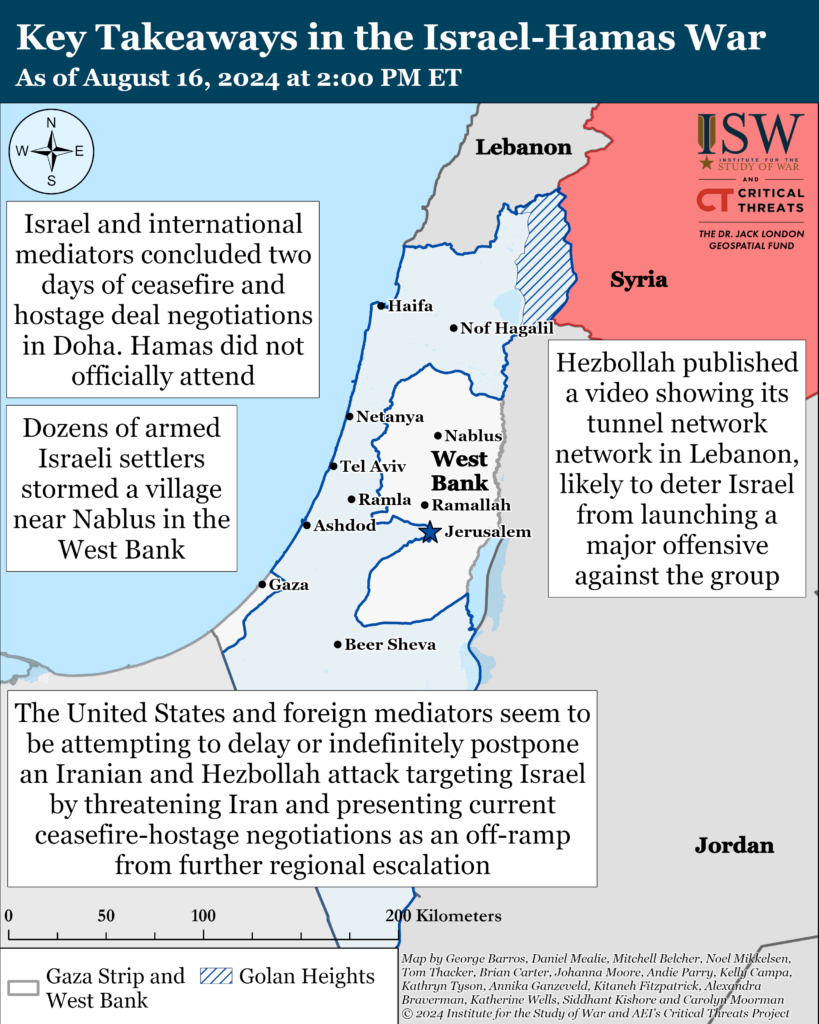
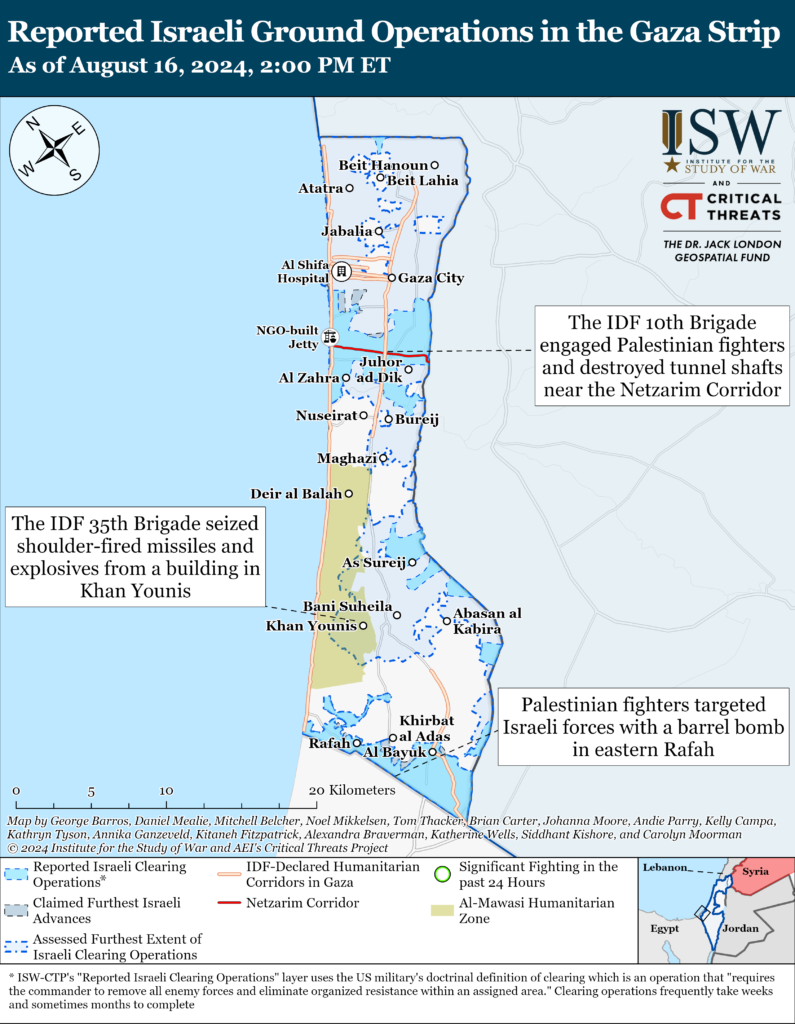
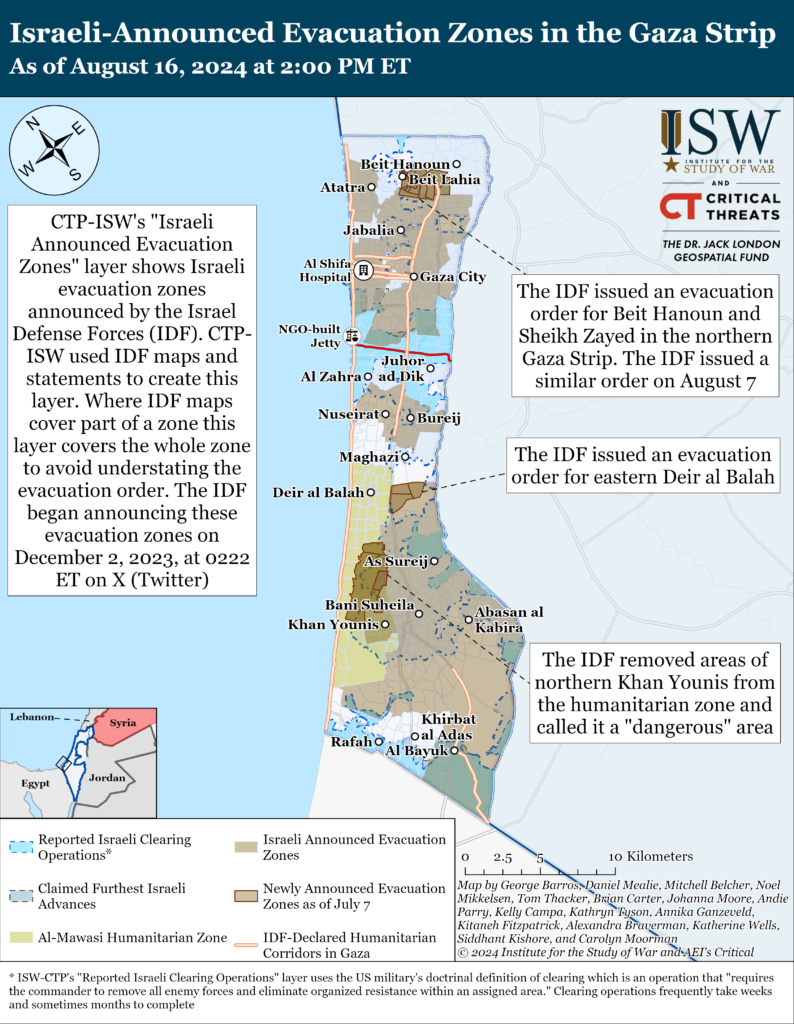
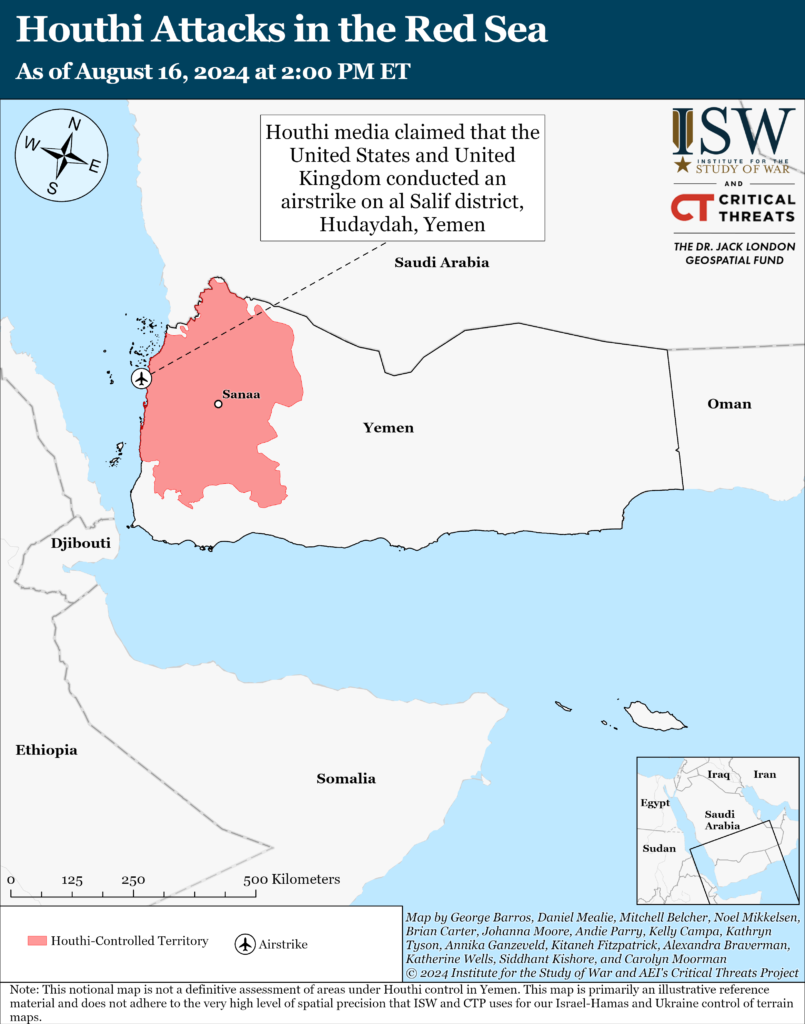
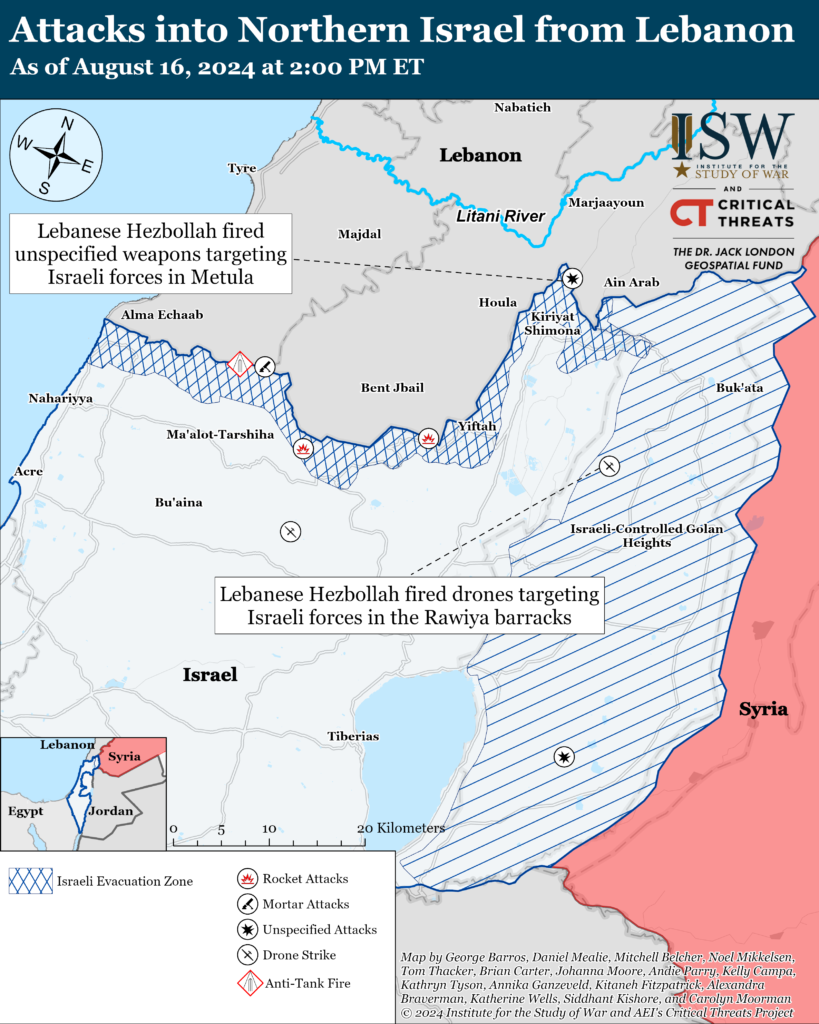
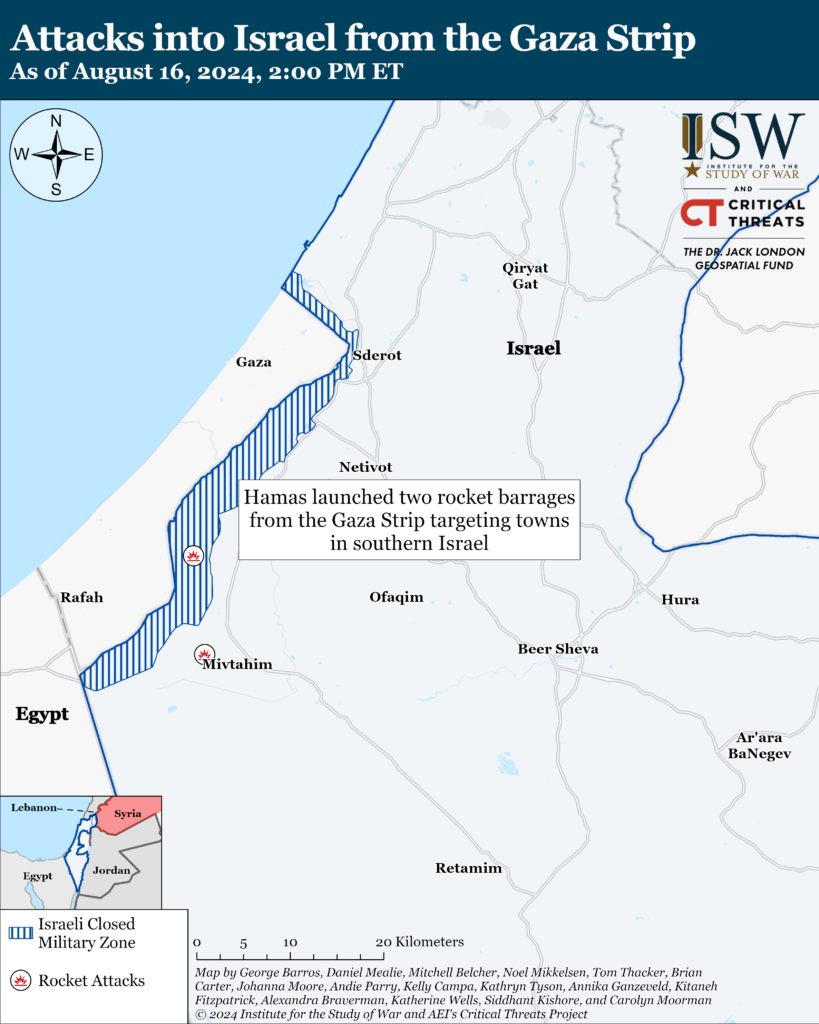
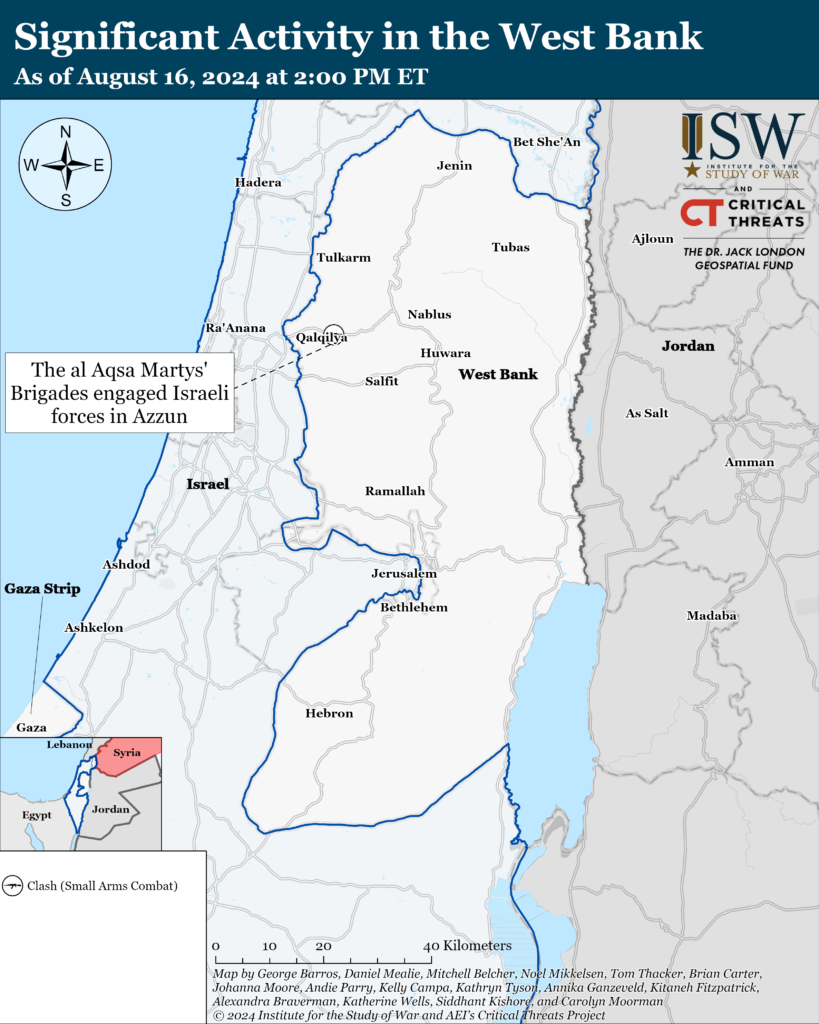
Gaza Strip
Axis of Resistance objectives:
Erode the will of the Israeli political establishment and public to sustain clearing operations in the Gaza Strip
Reestablish Hamas as the governing authority in the Gaza Strip
The Israel Defense Forces (IDF) issued an evacuation order for Beit Hanoun and Sheikh Zayed in the northern Gaza Strip on August 16.[43] The IDF said that Hamas and other Palestinian militias had recently launched rockets from the area at Israel.[44] The IDF said that it would act “forcefully” in the evacuation area.[45] The IDF issued a similar evacuation order for this general area on August 7 after Palestinian Islamic Jihad launched rocket from the area.[46] Israeli ground forces did not advance into Beit Hanoun after the August 7 attack. CTP-ISW previously noted that the IDF has not conducted clearing operations in all of the recent evacuation zones it has identified, suggesting the evacuation orders are no longer a reliable indicator for imminent Israeli ground operations in a sector of the Gaza Strip.[47] The IDF has conducted repeated low intensity clearing operations in Beit Hanoun since an initial clearing operation in Fall 2023 that rendered Hamas’ Beit Hanoun Battalion combat ineffective.[48] CTP-ISW assessed in March 2024 that a small number of Palestinian fighters had likely infiltrated Beit Hanoun.[49]
The IDF issued evacuation orders for eastern Deir al Balah, central Gaza Strip, on August 16.[50] The IDF said it would act “forcefully” against Palestinian militants who are firing rockets into Israel from the evacuation zone.[51] The IDF separately removed a section of northwest Khan Younis and southern Deir al Balah from the al Mawasi humanitarian zone on August 16.[52] The IDF removed the zones from the humanitarian zone because of attacks from the area targeting Israel.[53] The IDF said that it announced that it changed the status of the area to a combat zone in order to warn civilians and enable them to leave.[54] Palestinian journalists and militias have not reported an IDF presence in the re-designated area of the humanitarian zone at the time of this writing. Israeli forces have not previously cleared some of the evacuation zone in Deir al Balah.[55]
IDF 252nd Division continued operations along the Netzarim Corridor, south of Gaza City, on August 16. The IDF 10th Brigade destroyed tunnel shafts and engaged Palestinian fighters.[56] The IDF Navy struck several Palestinian fighters that posed a threat to Israeli forces near the Netzarim Corridor.[57] Several Palestinian militias claimed indirect fire attacks targeting Israeli forces.[58] Hamas launched rockets targeting Israeli forces along the corridor in its only claimed attack of the day inside the Gaza Strip.[59]
The IDF 98th Division continued clearing operations in northeast Khan Younis on August 16.[60] Israeli artillery shelled rocket launch sites that Palestinian fighters used to attack on Israel on August 15.[61] The IDF 35th Paratroopers Brigade seized shoulder-fired missiles and explosives from a building in Khan Younis.[62] The IDF Air Force struck and killed Palestinian fighters in Khan Younis, including drone operators.[63] The al Aqsa Martyrs’ Brigades—the self-proclaimed militant wing of Fatah—targeted Israeli forces with sniper fire in eastern Khan Younis.[64]
Israeli forces engaged Palestinian fighters in Rafah on August 16. The Palestinian Mujahideen Movement targeted an Israeli personnel carrier with a “barrel bomb” improved explosive device in eastern Rafah.[65] Palestinian fighters also mortared Israeli forces along the western section of the Philadelphi Corridor.[66]
IDF Air Force struck about 30 targets across the Gaza Strip over the past day, including militia buildings and Palestinian fighter cells.[67] Israeli forces struck and killed a Hamas fighter that ”promoted” attacks on the IDF during the war in an unspecified area of the Gaza Strip.[68]
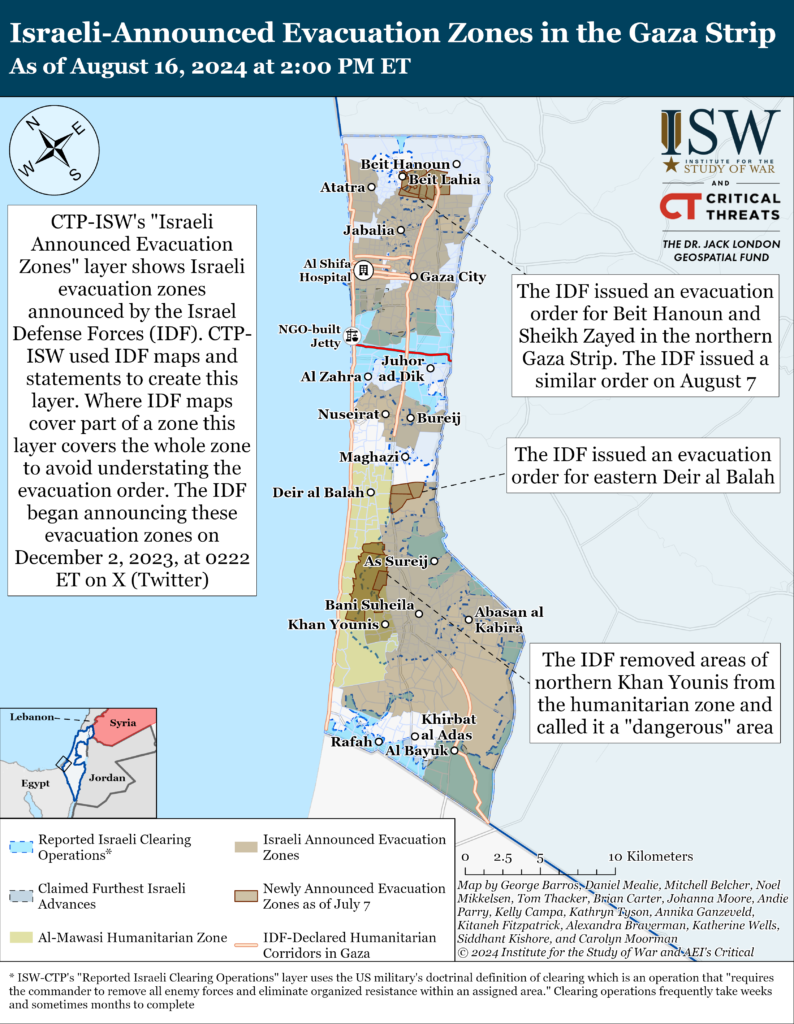
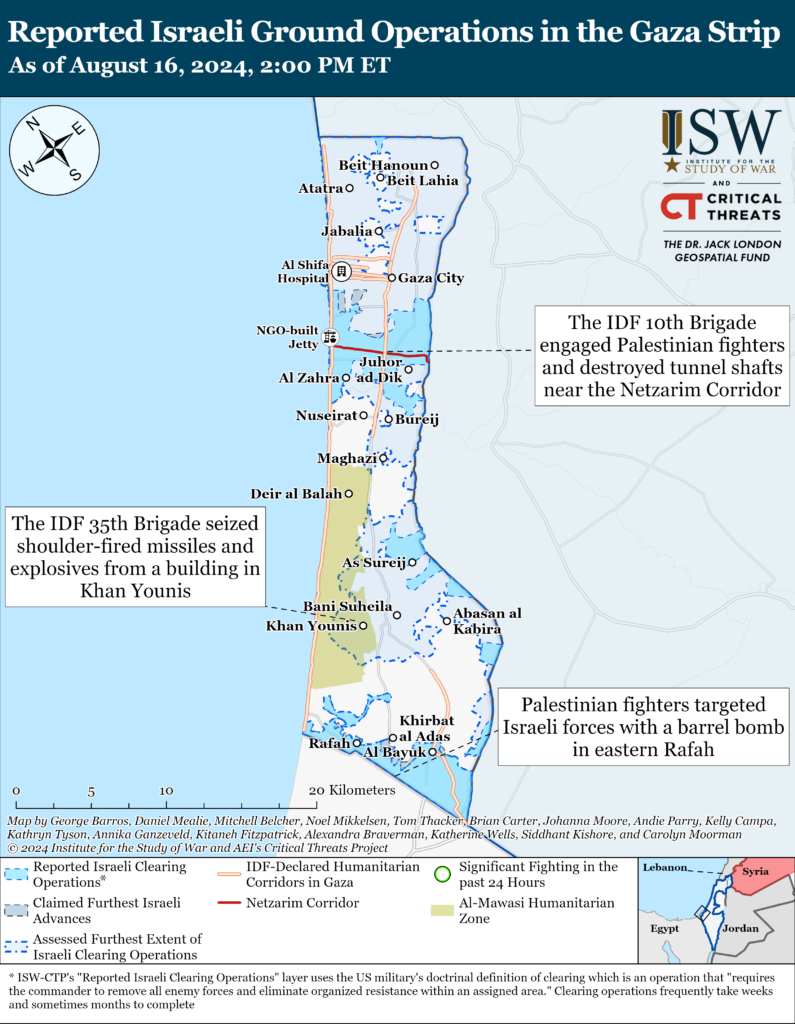
Hamas launched two rocket attacks targeting southern Israel from the Gaza Strip on August 16.[69] Hamas launched a barrage of five rockets targeting Nirim, southern Israel, from Khan Younis.[70] Israeli air defenses intercepted one rocket and the others landed in open areas.[71] Hamas separately targeted a town in southern Israel.[72]
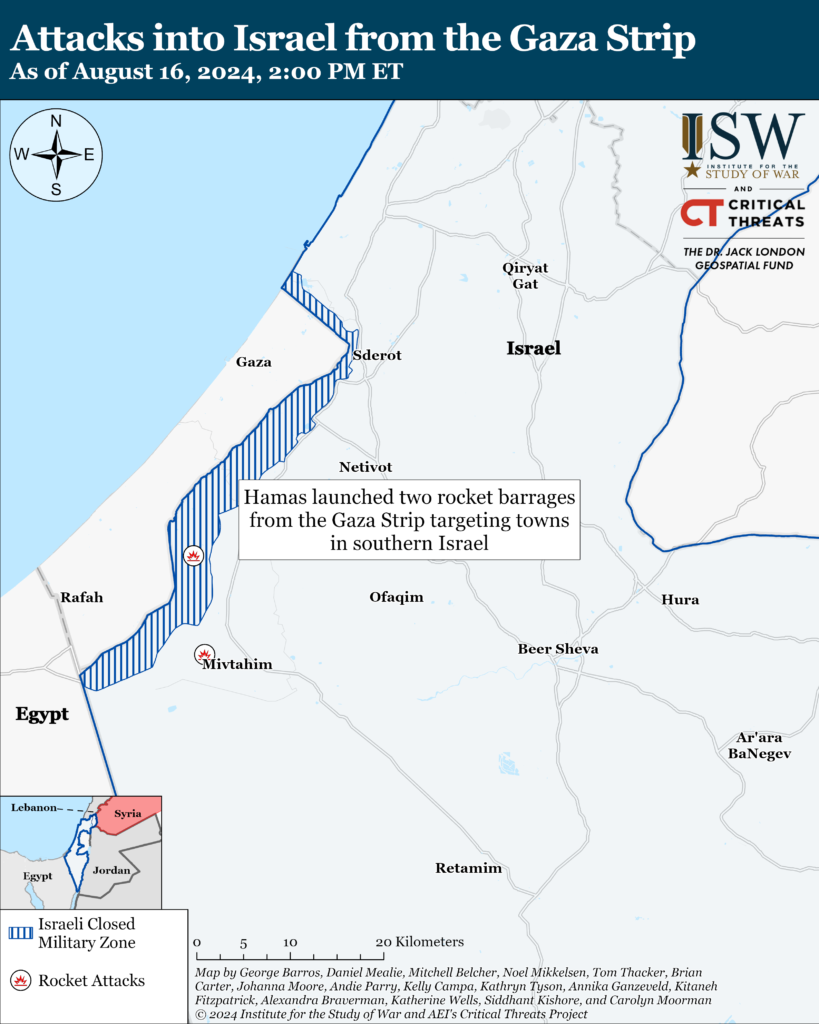
Recorded reports of attacks; CTP-ISW cannot independently verify impact.
West Bank
Axis of Resistance objectives:
Establish the West Bank as a viable front against Israel
The al Aqsa Martyrs’ Brigades engaged Israeli forces in Azzun, east of Qalqilya, on August 16.[73]
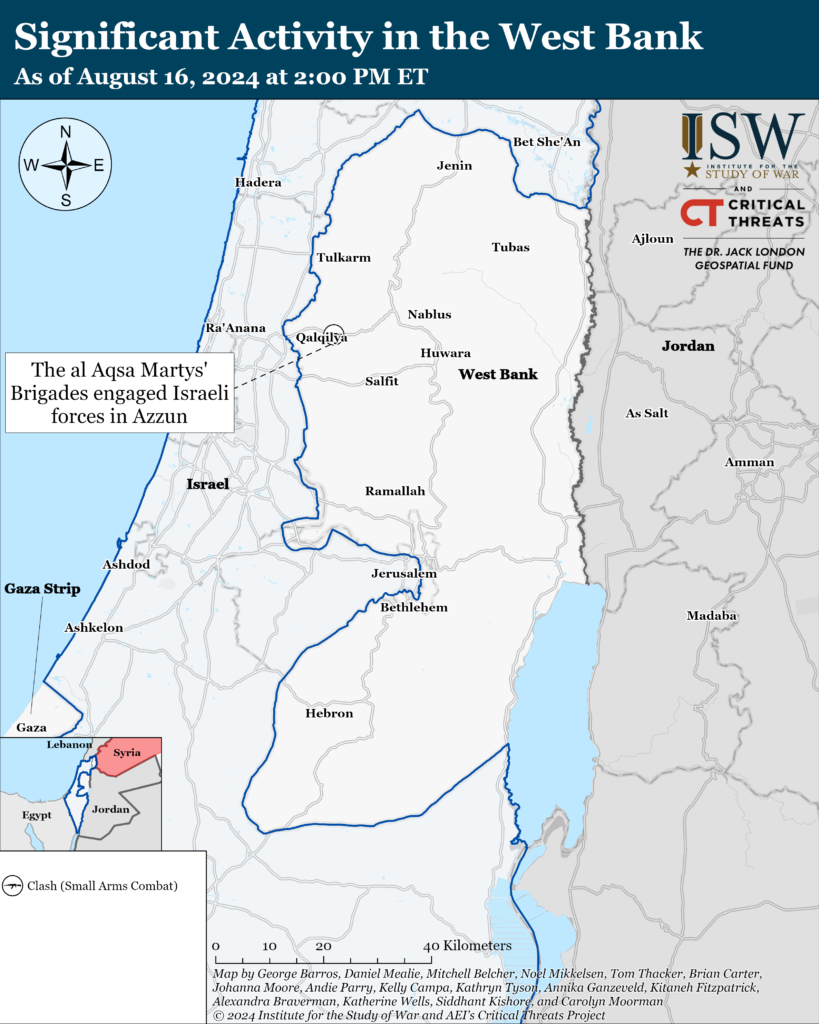
This map is not an exhaustive depiction of clashes and demonstrations in the West Bank.
Southern Lebanon and Golan Heights
Axis of Resistance objectives:
Deter Israel from conducting a ground operation into Lebanon
Prepare for an expanded and protracted conflict with Israel in the near term
Expel the United States from Syria
Iranian-backed militias, including Lebanese Hezbollah, have conducted at least nine attacks into northern Israel since CTP-ISW’s last data cutoff on August 15.[74]
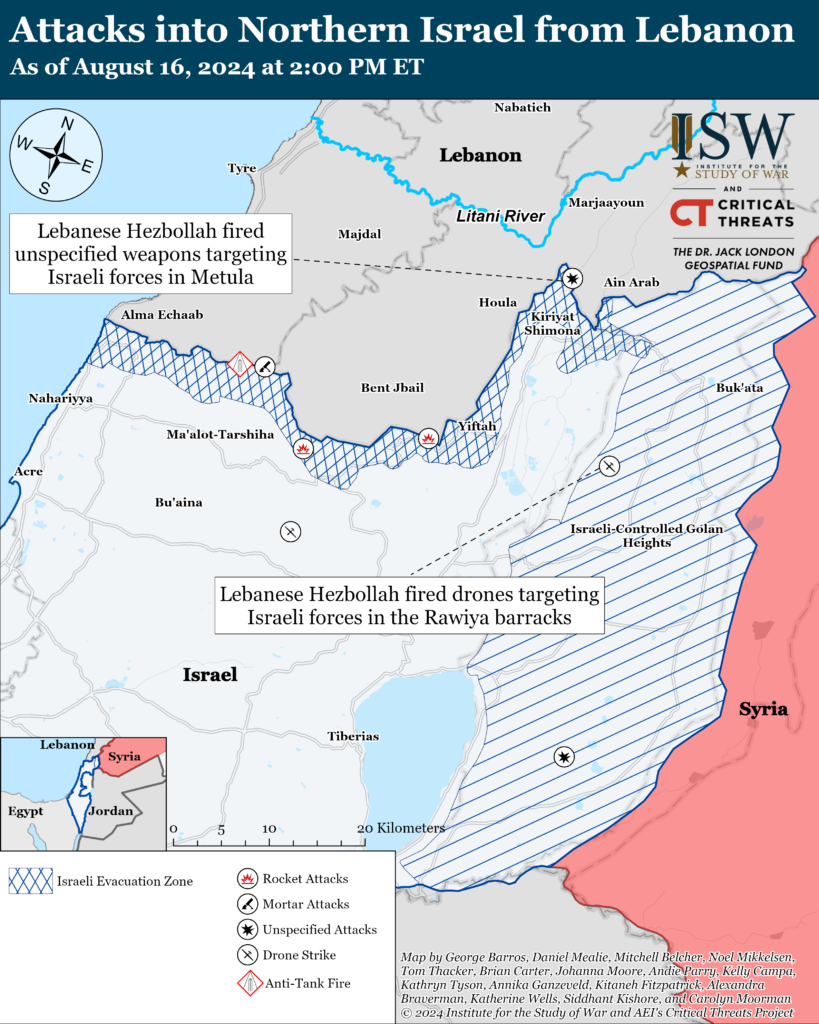
Iran and the Axis of Resistance
Houthi Supreme Leader Abdul Malik al Houthi stated that a response to the killing of Ismail Haniyeh is “coming inevitably” in his weekly speech on August 15.[75] Abdulmalik dismissed media reports that there has been a delay in the retaliation. Abdulmalik stated that the entire Axis of Resistance ”confirmed” that there must be a response to the killing of Haniyeh and that the decision to respond is ”decisive.” Abdulmalik stressed that Israelis are in a ”state of constant fear” in waiting for the retaliation.
US Central Command (CENTCOM) destroyed one Houthi ground control station in a Houthi-controlled area of Yemen on August 15.[76] CENTCOM determined that the ground control station presented an imminent threat to US and coalition forces, as well as merchant vessels in the region.
Houthi media claimed on August 15 that the United States and United Kingdom conducted an airstrike targeting al Salif district, Hudaydah, Yemen.[77]
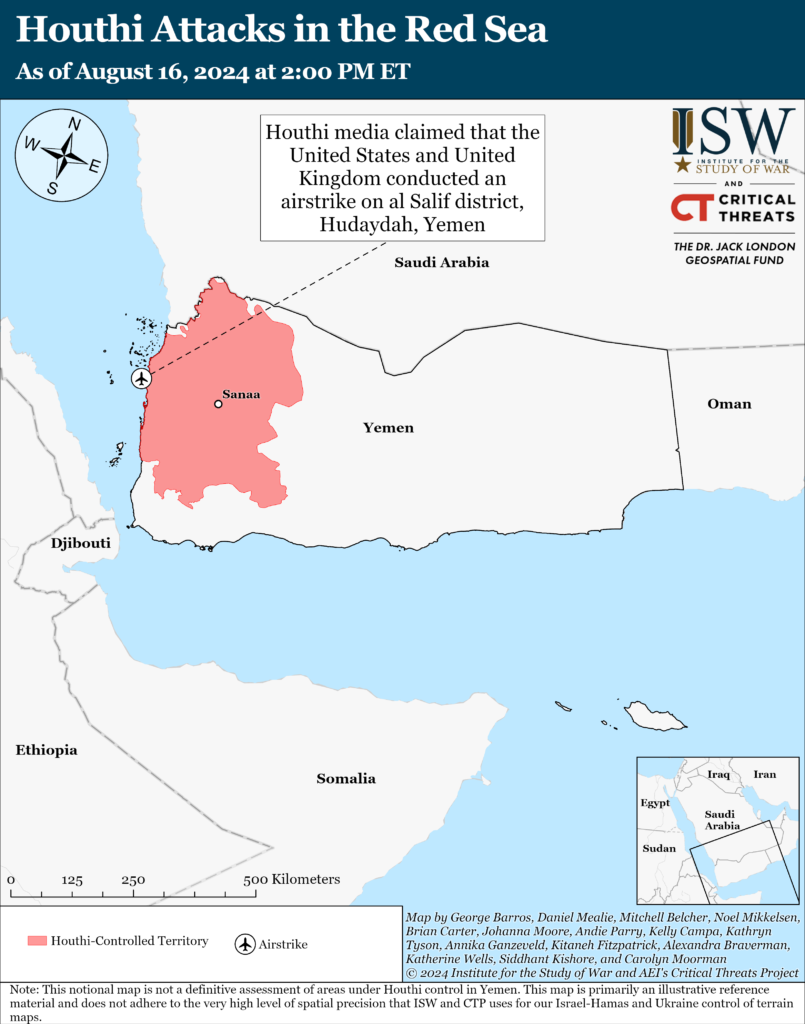
University of Tehran President Mohammad Moghimi announced on August 15 that the University of Tehran will accept members of the Iraqi Popular Mobilization Forces (PMF) without university entrance exams.[78] Moghimi stated that these students would not receive military training and would instead study ”management.” Managerial studies could presumably be applied within military organizations to improve a fighters’ leadership skills and potential, including their ability to organize large organizations. Moghimi stated that this is part of a larger partnership with Iraq to strengthen the education of members of the Axis of Resistance.[79] Moghimi stated that Iraqi authorities previously expressed dissatisfaction with the quality of education of certain unspecified Iranian universities for PMF students. The University of Tehran began admitting PMF members in 2023.[80]
South African Navy Commander Admiral Monde Lobese discussed naval cooperation and maritime security with Iranian security officials in Iran between August 11 to August 16.[81] Lobese met with Artesh Navy Commander Admiral Shahram Irani and IRGC Navy Commander Alireza Tangsiri. Lobese and Irani “share[d] insights on operational strategies and discuss[ed] regional security challenges.”[82] Lobese toured the Imam Khomeini Naval University in Noshahr, Iran, and the Artesh Navy’s Southern Fleet. Lobese inspected the Iranian-built warship Dena, which had previously docked in Cape Town, South Africa, in April 2023 during an Artesh Navy global voyage.[83] Irani and Lobese last met in St. Petersburg, Russia, in July 2023 to discuss enhancing bilateral naval ties.[84] The meeting was a part of a larger discussion between Venezuelan, South African, and Iranian naval chiefs on naval cooperation.
An unspecified number of “armed criminals” clashed with police officers and shot and killed “conscript” Ali Raufian at Zahedan Qalabid police station, Sistan and Baluchistan province, on August 16.[85] The suspects remain at large.
 Eurasia Press & News
Eurasia Press & News
